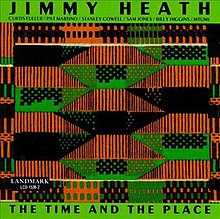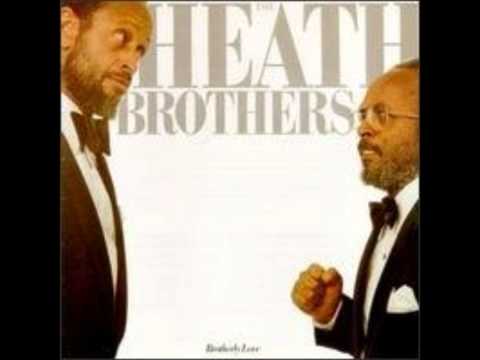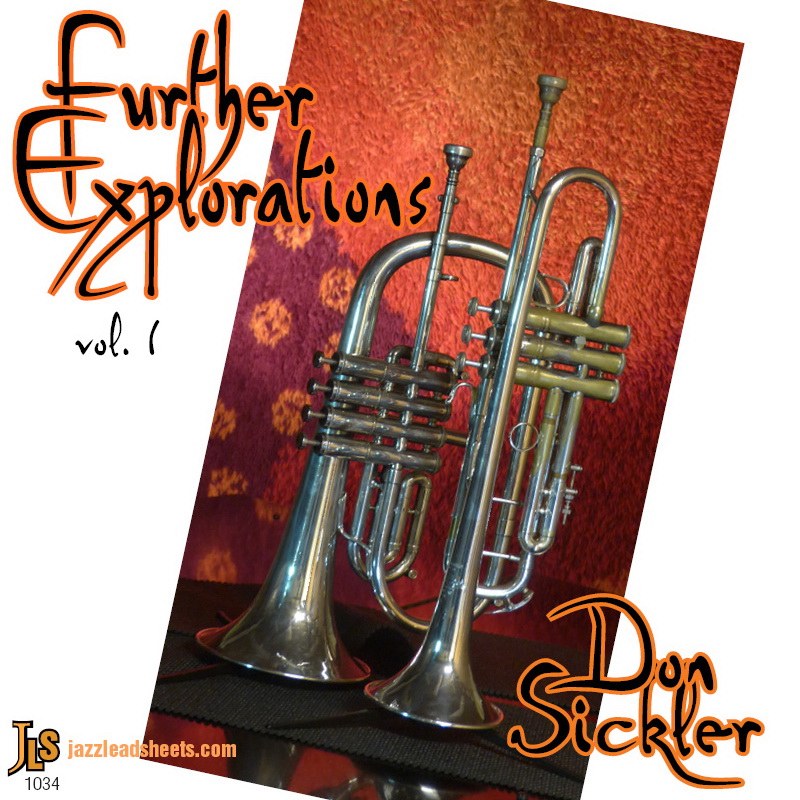No End – Kenny Dorham
This beautiful bossa-tempo song was not recorded in Kenny Dorham's lifetime, but lives on in the repertoire of Jimmy Heath. We also have a "Further Explorations" version with Minus You tracks for all instruments.
- Recording: Jimmy Heath - The Time And The Place
- Recorded on: June 24, 1974
- Label: Landmark (LCD 1538 2)
- Concert Key: E-flat
- Vocal Range: , to
- Style: Latin (medium)
- Soprano Sax, Vocals - Jimmy Heath
- Guitar - Pat Martino
- Piano - Stanley Cowell
- Bass - Sam Jones
- Drums - Billy Higgins
- Congas, Vocals - James Mtume Heath
- Vocals - Curtis Fuller
0:00
0:00
Buy MP3
Video
- Description
- Historical Notes
- Solos
- Piano Corner
- Bass Corner
- Drum Corner
- Guitar Corner
- Inside & Beyond
- Minus You
The title of this song is quite literal: the form is cyclic, with no resolution at the end but instead a harmonic loop back to the beginning. There are no repeats in the form, which is 28 measures long divided into a 16-measure A section and 12-measure B. Though this is all made up of four-measure phrases, the melody flows freely with that classic Dorham momentum. It's a serene, majestic melody in a similar mood to Escapade and La Mesha. The changes are mostly in an E♭ major tonality, but the B section travels to G♭, E, and B major. There is a two-measure bass figure that is repeated down a whole step, on the first two chords of E♭maj9 and D♭9; the same figure returns for the G♭maj7 and Emaj9 chords in the B section. A bass part is available.
Our audio excerpt starts with the bass pickup to the melody, but on the recording, Jimmy, his son and Curtis Fuller sing K.D.'s opening part of Kenny's original intro. The intro alternates E♭ and D♭ chords. It begins rubato with the two chords held out twice, each with an identical three-note melody phrase; on this recording the words "There's no end" are sung by band members (and harmonized a fourth above) CLIP. The bass then comes in with the same figure from the A section, again repeated twice for a total of eight measures. The coda is the same but with the sections switched: eight measures of rhythm section in time with the bass figure, and then the same rubato section with the vocals. You can also hear this opening rubato intro (instrumentally) on our audio excerpt of Jimmy's later recording of No End.
Don Sickler: "I'll never forget the day that Curtis asked me: 'What about K.D.'s composition No End?' I told him I wasn't familiar with that title. Curtis then sang the melody to the whole song, which totally blew me away. Curtis said I should also talk to Jimmy Heath about the song, as K.D. had taught the song to both of them. I talked to Jimmy, who, like Curtis, proceeded to sing the entire melody for me! Jimmy said he'd already recorded it (1974-Landmark label). We're now making the music available so everyone can play it."
Our audio excerpt starts with the bass pickup to the melody, but on the recording, Jimmy, his son and Curtis Fuller sing K.D.'s opening part of Kenny's original intro. The intro alternates E♭ and D♭ chords. It begins rubato with the two chords held out twice, each with an identical three-note melody phrase; on this recording the words "There's no end" are sung by band members (and harmonized a fourth above) CLIP. The bass then comes in with the same figure from the A section, again repeated twice for a total of eight measures. The coda is the same but with the sections switched: eight measures of rhythm section in time with the bass figure, and then the same rubato section with the vocals. You can also hear this opening rubato intro (instrumentally) on our audio excerpt of Jimmy's later recording of No End.
Don Sickler: "I'll never forget the day that Curtis asked me: 'What about K.D.'s composition No End?' I told him I wasn't familiar with that title. Curtis then sang the melody to the whole song, which totally blew me away. Curtis said I should also talk to Jimmy Heath about the song, as K.D. had taught the song to both of them. I talked to Jimmy, who, like Curtis, proceeded to sing the entire melody for me! Jimmy said he'd already recorded it (1974-Landmark label). We're now making the music available so everyone can play it."
This is the first of three recordings of this song by Jimmy Heath. Click on the second album cover for the version from his 1981 album "Brotherly Love." Stanley Cowell played on this recording as well. A third Jimmy Heath version comes from his big band album "Turn Up The Heath," recorded in 2006.
Though Curtis Fuller isn't playing trombone on this first recording of this song, he participates in the group vocals in the intro and coda. Guitarist Pat Martino had previously recorded with Jimmy Heath on Don Patterson's 1973 album "These Are Soulful Days."
Though Curtis Fuller isn't playing trombone on this first recording of this song, he participates in the group vocals in the intro and coda. Guitarist Pat Martino had previously recorded with Jimmy Heath on Don Patterson's 1973 album "These Are Soulful Days."
Related Songs
Email Send No End to a friend
Send this page to a friend via email. Add your name or email in the first field. In the second, add one or more email addresses, separated by a comma.
- Recording: Heath Brothers - Brotherly Love
- Recorded on: December 29-30, 1981
- Label: Antilles (AN 1003)
- Concert Key: E-flat
- Vocal Range: , to
- Style: Latin (medium slow)
- Soprano Sax - Jimmy Heath
- Guitar - Tony Purrone
- Piano - Stanley Cowell
- Bass - Percy Heath
- Drums - Akira Tana
- Percussion - Rubens Bassini
Video
- Description
- Historical Notes
- Solos
- Piano Corner
- Bass Corner
- Drum Corner
- Guitar Corner
- Inside & Beyond
- Minus You
As Jimmy Heath continued to play No End over the years, the arrangement became more defined. A C treble clef lead sheet is available which reflects this 1981 version. A bit slower than the first recording, there is a more obvious bossa groove in the drums and percussion. Despite the slower tempo at the head, the rubato intro moves along a little more than in the original recording; it's played instrumentally without that version's group vocals. There are piano and guitar chord hits complementing the bass line at the beginning of A and B, as well as on the in-tempo sections of the intro and coda. A simpler version of these hits are also played in the solos; we show both sets of hits in our lead sheet. On the last measure of A and last measure of B, the rhythm section hits beats 1 and 2 (the latter held out as a dotted half note) in every chorus.
"Brotherly Love" was the last of four albums credited as The Heath Brothers but without Tootie Heath on drums. All four have Stanley Cowell on piano and Tony Purrone on guitar, as does "Passing Thru," a 1978 album with all three Heath brothers as well as Jimmy's son James Mtume Heath on percussion and a four-piece brass section. The next Heath Brothers album after "Brotherly Love" was "Brothers & Others," recorded in 1983 with Tootie back on drums and Stanley Cowell again on piano.
Related Songs
Email Send No End to a friend
Send this page to a friend via email. Add your name or email in the first field. In the second, add one or more email addresses, separated by a comma.
- Recording: Don Sickler - Further Explorations Vol. 1
- Recorded on: May 3, 2005
- Label: jazzleadsheets.com (JLS 1034)
- Concert Key: F
- Vocal Range: , to
- Style: Latin (medium slow)
- Flugelhorn - Don Sickler
- Piano - Norman Simmons
- Bass - Tim Givens
- Drums - Vince Cherico
Video
- Description
- Historical Notes
- Solos
- Piano Corner
- Bass Corner
- Drum Corner
- Guitar Corner
- Inside & Beyond
- Minus You
Our Further Explorations version with Minus You tracks is a whole step higher than the Jimmy Heath recordings, in the key of F. This is a good key for trumpet or flugelhorn in the lower register; the melody is relatively high for trumpet in the original key, in the octave that Jimmy Heath plays it on soprano sax, but would be too low an octave below. For this version we have two B♭ melody parts: one in the lower octave where Don Sickler plays it on flugelhorn, and another with the head written an octave higher which would work for tenor sax or soprano sax in their respective ranges.
This recording adds a bit of an arrangement in the intro and coda, including piano and drum hits that "answer" the bass on the first four measures of bass figures in both. There is also an extension of the melody into the coda.
Because the first eight measures of the intro and last eight measures of the coda are rubato and directed, we show fermatas on the melody notes in the second measure of each two-measure chord, but not on the rhythm section cue notes. The rhythm section holds out each chord, and you can choose where to place the melody phrase within these holds.
As with many Kenny Dorham compositions, the bass part is very important in this song. Besides a Minus Melody version, we have a bass part for a Minus Bass track. Cymbal cues have been added in this track to set up the tempo for the second half of the intro.
This recording adds a bit of an arrangement in the intro and coda, including piano and drum hits that "answer" the bass on the first four measures of bass figures in both. There is also an extension of the melody into the coda.
Because the first eight measures of the intro and last eight measures of the coda are rubato and directed, we show fermatas on the melody notes in the second measure of each two-measure chord, but not on the rhythm section cue notes. The rhythm section holds out each chord, and you can choose where to place the melody phrase within these holds.
As with many Kenny Dorham compositions, the bass part is very important in this song. Besides a Minus Melody version, we have a bass part for a Minus Bass track. Cymbal cues have been added in this track to set up the tempo for the second half of the intro.
For more "Further Explorations" tracks featuring master pianist Norman Simmons, check out The Court, I Remember Love, Look At Her and Sweet Life. More Minus You recordings with Norman are coming soon to jazzleadsheets.com.
Exclusive Minus You audio tracks
Format of the full track:
-- intro
-- melody
-- flugelhorn solo 1 chorus
-- piano solo 1 chorus
-- out melody
-- coda
CLIP minus melody - this track has only one solo chorus
-- play the first eight measures of the intro
-- rest for the second eight measures of the intro (or solo)
-- play the melody
-- solo 1 chorus
-- play the out melody and coda
CLIP minus Bass (there's a separate Bass part; cymbal hits added to help set the time)
-- play the intro
-- play figures and 2-feel for the melody, flugelhorn solo 1 chorus, piano solo 1 chorus, and out melody
-- play the coda
CLIP minus Drums
-- play the intro
-- comp for the melody, flugelhorn solo 1 chorus, piano solo 1 chorus, and out melody
-- play the coda
Format of the full track:
-- intro
-- melody
-- flugelhorn solo 1 chorus
-- piano solo 1 chorus
-- out melody
-- coda
CLIP minus melody - this track has only one solo chorus
-- play the first eight measures of the intro
-- rest for the second eight measures of the intro (or solo)
-- play the melody
-- solo 1 chorus
-- play the out melody and coda
CLIP minus Bass (there's a separate Bass part; cymbal hits added to help set the time)
-- play the intro
-- play figures and 2-feel for the melody, flugelhorn solo 1 chorus, piano solo 1 chorus, and out melody
-- play the coda
CLIP minus Drums
-- play the intro
-- comp for the melody, flugelhorn solo 1 chorus, piano solo 1 chorus, and out melody
-- play the coda
Related Songs
Email Send No End to a friend
Send this page to a friend via email. Add your name or email in the first field. In the second, add one or more email addresses, separated by a comma.

Kenny Dorham
August 30, 1924 – December 15, 1972
August 30, 2025, is Kenny Dorham's 101st birthday: jazzleadsheets.com has added many new K.D. compositions. Jazz At Lincoln Center has dedicated three late-night sets to Kenny's music, played with love by young musicians who want his music to live on. Join in, play K.D. music! Read more...
There was a problem.
...



